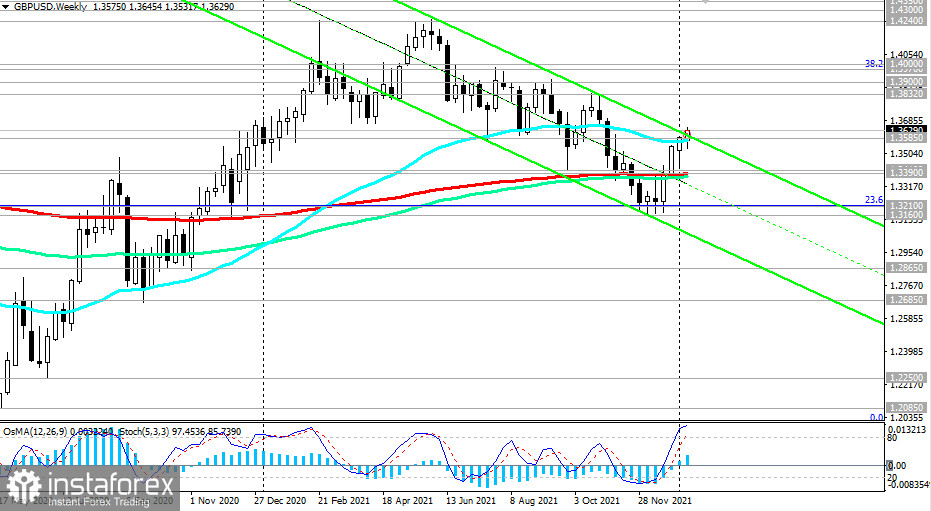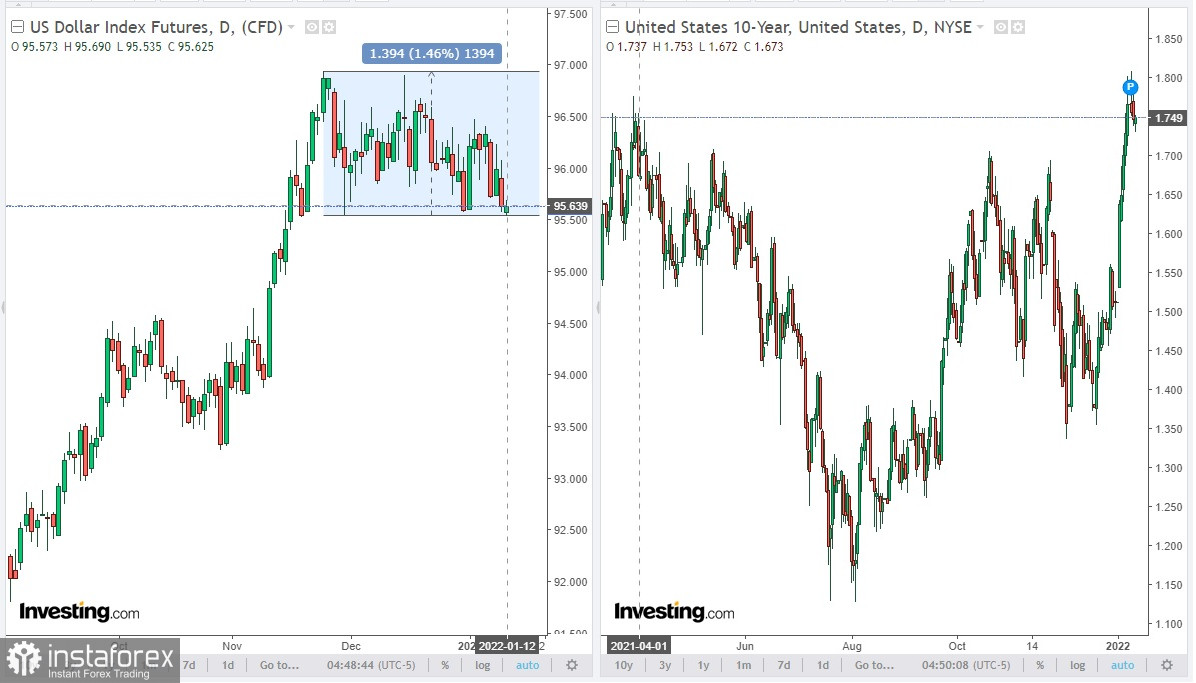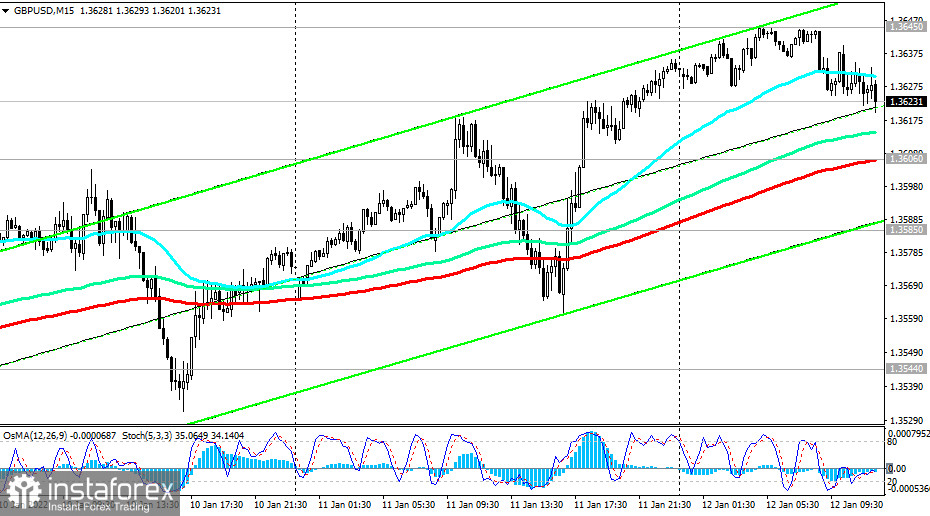Fed Chairman Jerome Powell said Tuesday that the central bank's officials are ready to begin raising interest rates to "prevent higher inflation from becoming entrenched" and overheating the economy. "If we see inflation persisting at high levels longer than expected, if we have to raise interest rates more over time, then we will," Powell added. However, he expects "a return to normal supply conditions."
As a result of the December meeting, Fed policymakers planned three rate hikes of 0.25% each, and as it became clear from the minutes published last week, the process of raising interest rates is likely to begin as early as March.
The dollar fell on Tuesday despite Powell's speech. The GBP/USD pair broke through resistance at 1.3585 yesterday and reached a new 10-week high of 1.3645 during the Asian session today.

Market participants may have been focused on Powell's words that it would take time for interest rates to return to pre-pandemic levels. "We're really just going to be moving over the course of this year to a policy that is closer to normal. But it's a long road to normal from where we are," Powel stated.
The Fed is in a difficult situation. On the one hand, the huge amounts of stimulus from the central bank and the US government have been a forced measure to deal with disruptions in the economy caused by the pandemic. On the other hand, they have accelerated inflation, leaving the central bank facing the need to tighten its policy at a time when inflation is well above multi-year highs. Fed policymakers, however, fear that a sharp rise in rates would lead to a worsening of the labor market. Anyway, despite the significant improvement in the labor market (the unemployment rate fell to 3.9% in December, down from four years ago), the number of jobs is 3.6 million fewer than it was before the pandemic.
At the same time, high wages and increased demand for goods led to supply chain disruptions and shortages, pushing the annual rate of inflation to its highest level in decades. The Core PCE, the Fed's preferred measure of inflation that excludes volatile food and energy prices, rose by 4.7% year-over-year in November, well above the central bank's target of 2.0%.
Investors concluded that the actions of the Fed officials are not yet definitively predetermined and may be adjusted again depending on the situation. This returned their interest in buying more profitable assets, which also predetermined the decline of the dollar. On Tuesday, the S&P 500 US broad market index was up by 2.9% from the local three-week low of 4,582.0 hit earlier in the week, while the dollar index fell to a local low of 95.54 hit in late November.

The risk appetite returns and forces strategic investors to refrain from traditional protective government bonds, which pushes their yields up (at the end of last week, the yield on US 10-year bonds reached 1.808%, which corresponds to the levels of early April 2021). This is a balancing factor in this situation providing support to the dollar.
As noted above, the further actions of the Fed officials are still not definitively predetermined, and amid the fact that some of the world's major central banks (for example, the Reserve Bank of New Zealand, and the Bank of England) have already begun to raise their interest rates, the dollar growth will not have an aggressive nature, although the dollar index is likely to have the potential for further growth.
Today market participants expect the Department of Labor Statistics report and data on consumer prices, which will be released at 1:30 p.m. (GMT). Annual consumer inflation is expected to grow to 7.0% in December being an all-time high in 40 years (the CPI, excluding food and energy prices, is projected to have risen at an annualized rate of +5.4% in December after rising to +4.9% in the previous month). If the forecasts come true, the dollar may rise sharply in the short term including in the GBP/USD pair. This data may strengthen the sentiment of Fed policymakers to raise interest rates in the coming months.
A breakdown of the key support level 1.3585 and fixation below 1.3585 will form a signal for a possible resumption of the GBP/USD pair decline and its return to a long-term downtrend.

Meanwhile, the pound remains the strongest of the major currencies at the beginning of 2022. It is supported by expectations of further interest rate hikes in the UK. The main interest rate of the Bank of England is 0,25%, the same as the Fed's. However, the Bank of England is so far ahead of the Fed in the process of tightening monetary policy, having raised the interest rate back in December, and investors are positive about the success of the anti-vaccination campaign in the UK and consider in the pound quotation further steps of the Bank of England in tightening monetary policy amid strongly growing inflation in the country amid positive macroeconomic data.
Support levels: 1.3605, 1.3585, 1.3544, 1.3444, 1.3410, 1.3390, 1.3300, 1.3210, 1.3160, 1.3000, 1.2865, 1.2685
Resistance levels: 1.3645, 1.3700, 1.3832, 1.3900, 1.3970, 1.4000

Trading recommendations
GBP/USD: Sell Stop 1.3585. Stop-Loss 1.3650. Take-Profit 1.3544, 1.3444, 1.3410, 1.3390, 1.3300, 1.3210, 1.3160, 1.3000, 1.2865, 1.2685
Buy Stop 1.3650. Stop-Loss 1.3585. Take-Profit 1.3700, 1.3832, 1.3900, 1.3970, 1.4000
 English
English 
 Русский
Русский Bahasa Indonesia
Bahasa Indonesia Bahasa Malay
Bahasa Malay ไทย
ไทย Español
Español Deutsch
Deutsch Български
Български Français
Français Tiếng Việt
Tiếng Việt 中文
中文 বাংলা
বাংলা हिन्दी
हिन्दी Čeština
Čeština Українська
Українська Română
Română

